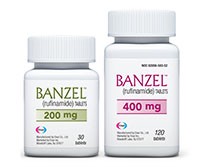
Contents
Banzel
Rufinamide tablets are a prescription medicine used with other medicines to treat seizures associated with Lennox-Gastaut Syndrome (LGS) in adults and pediatric patients 1 year of age and older. It is not known if rufinamide tablets are safe and effective in the treatment of Lennox-Gastaut Syndrome in pediatric patients under 1 year of age.
What are the side effects of Banzel?
Rufinamide tablets may cause serious side effects including:
- Rufinamide tablets can also cause allergic reactions or serious problems affecting organs like the liver or blood cells. You may or may not have a rash with these reactions.
Call your healthcare provider right away if you have any of the following symptoms:
- swelling of the face, eyes, lips, or tongue
- trouble swallowing or breathing
- a skin rash
- hives
- fever, swollen glands, or sore throat that do not go away or come and go
- yellowing of the skin or eyes
- dark urine
- unusual bruising or bleeding
- severe fatigue or weakness
- severe muscle pain
- more frequent or worsening seizures
Call your healthcare provider right away if you experience any of these symptoms.
The most common side effects of rufinamide tablets include:
Tell your healthcare provider about any side effect that bothers you or that does not go away. These are not all possible side effects of rufinamide tablets. For more information, ask your healthcare provider or pharmacist.
Call your doctor for medical advice about side effects. You may report side effects to FDA at 1-800-FDA-1088.
What is the dosage for Banzel?
Pediatric Patients (1 Year to Less Than 17 Years)
- The recommended starting daily dose of rufinamide in pediatric patients with Lennox-Gastaut Syndrome is approximately 10 mg/kg administered in two equally divided doses.
- The dose should be increased by approximately 10 mg/kg increments every other day until a maximum daily dose of 45 mg/kg, not to exceed 3,200 mg, administered in two equally divided doses, is reached.
- It is not known whether doses lower than the target doses are effective.
Adults (17 Years and Older)
- The recommended starting daily dose of rufinamide in adults with Lennox-Gastaut Syndrome is 400 mg per day to 800 mg per day administered in two equally divided doses.
- The dose should be increased by 400 mg to 800 mg every other day until a maximum daily dose of 3200 mg, administered in two equally divided doses, is reached. It is not known whether doses lower than 3,200 mg are effective.
Administration Information
- Administer rufinamide with food. Rufinamide film-coated tablets can be administered whole, as half tablets or crushed.
Dosing in Patients Undergoing Hemodialysis
- Hemodialysis may reduce exposure to a limited extent. Adjusting the rufinamide dose during the dialysis process should be considered.
Dosing in Patients With Hepatic Disease
- Use of rufinamide in patients with hepatic impairment has not been studied.
- Therefore, use in patients with severe hepatic impairment is not recommended. Caution should be exercised in treating patients with mild to moderate hepatic impairment.
Dosing in Patients Taking Valproate
- Patients taking valproate should begin rufinamide at a lower dose than those not taking valproate.
What drugs interact with Banzel?
Effects of Rufinamide on Other AEDs
Population pharmacokinetic analysis of average concentration at steady state of carbamazepine, lamotrigine. phenobarbital, phenytoin, topiramate, and valproate showed that typical rufinamide Cmax levels had little effect on the pharmacokinetics of other AEDs. Any effects, when they occur, have been more marked in the pediatric population.
Table 6 summarizes the drug-drug interactions of rufinamide with other AEDs.
Table 6: Summary of drug-drug interactions of rufinamide with other antiepileptic drugs
| AED Co-administered | Influence of Rufinamide on AED concentration | Influence of AED on Rufinamide concentration |
| Carbamazepine | Decrease by 7 to 13% | Decrease by 19 to 26% Dependent on dose of carbamazepine |
| Lamotrigine | Decrease by 7 to 13% | No Effect |
| Phenobarbital | Increase by 8 to 13% | Decrease by 25 to 46% Independent of dose or concentration of phenobarbital |
| Phenytoin | Increase by 7 to 21% | Decrease by 25 to 46% Independent of dose or concentration of phenytoin |
| Topiramate | No Effect | No Effect |
| Valproate | No Effect | Increase by < 16 to 70% Dependent on concentration of valproate |
| Primidone | Not Investigated | Decrease by 25 to 46% Independent of dose or concentration of primidone |
| Benzodiazepines | Not Investigated | No Effect |
| a Predictions are based on rufinamide concentrations at the maximum recommended dose of rufinamide.
b Maximum changes predicted to be in pediatric patients and in adult patients who achieve significantly higher levels of rufinamide, as the effect of rufinamide on these AEDs is concentration-dependent. c Larger effects in pediatric patients at high doses/concentrations of AEDs. d Phenobarbital, primidone and phenytoin were treated as a single covariate (phenobarbital-type inducers) to examine the effect of these agents on rufinamide clearance. e All compounds of the benzodiazepine class were pooled to examine for ‘class effect’ on rufinamide clearance. |
||
Phenytoin: The decrease in clearance of phenytoin estimated at typical levels of rufinamide (Cavss 15µg/mL) is predicted to increase plasma levels of phenytoin by 7 to 21%. As phenytoin is known to have non-linear pharmacokinetics (clearance becomes saturated at higher doses), exposure may be greater than predicted.
Effects of Other AEDs on Rufinamide
- Potent cytochrome P450 enzyme inducers, such as carbamazepine, phenytoin, primidone, and phenobarbital, appear to increase the clearance of rufinamide (see Table 6).
- Given that the majority of clearance of rufinamide is via a non-CYP-dependent route, the observed decreases in blood levels seen with carbamazepine, phenytoin, phenobarbital, and primidone are unlikely to be entirely due to enzyme induction.
- Other factors explaining this interaction are not understood. Any effects, when they occur, are likely to be more pronounced in the pediatric population.
Valproate
- Patients stabilized on rufinamide before being prescribed valproate should begin valproate therapy at a low dose, and titrate to a clinically effective dose.
- Similarly, patients on valproate should begin rufinamide at a lower dose than those not taking valproate.
Effects of Rufinamide on Hormonal Contraceptives
- Female patients of childbearing age should be warned that the concurrent use of rufinamide with hormonal contraceptives may reduce the effectiveness of this method of contraception.
- Additional non-hormonal forms of contraception are recommended when using rufinamide.
Is Banzel safe to use while pregnant or breastfeeding?
- There are no adequate and well-controlled studies in pregnant women.
- Rufinamide should be used during pregnancy only if the potential benefit justifies the potential risk to the fetus.
- Rufinamide produced developmental toxicity when administered orally to pregnant animals at clinically relevant doses.
- Rufinamide is likely to be excreted in human milk.
- Because of the potential for serious adverse reactions in nursing infants from rufinamide, a decision should be made whether to discontinue nursing or discontinue the drug taking into account the importance of the drug to the mother.
Summary
Rufinamide tablets are a prescription medicine used with other medicines to treat seizures associated with Lennox-Gastaut Syndrome (LGS) in adults and pediatric patients 1 year of age and older. It is not known if rufinamide tablets are safe and effective in the treatment of Lennox-Gastaut Syndrome in pediatric patients under 1 year of age.


